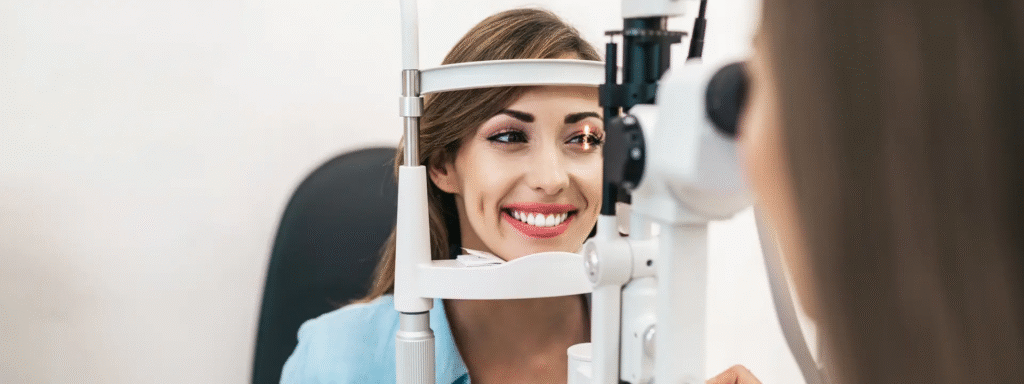Treatment Overview
Upper Canthoplasty is a specialized eyelid surgery that focuses on the upper canthus (outer corner of the upper eyelid) to adjust its shape, angle, and position. This procedure is often performed to enhance eye symmetry, correct congenital deformities, or revise complications from previous surgeries. In Korea, upper canthoplasty is commonly combined with double eyelid surgery or lateral canthoplasty to create a more refined and balanced eye shape, while using advanced microsurgical methods that minimize scarring and ensure natural results.
Purpose & Benefits
- Corrects asymmetry of the upper eye corners
- Enhances eye balance and proportion
- Softens a sharp or droopy upper canthus
- Repairs congenital deformities or post-surgical complications
- Improves harmony when combined with double eyelid surgery
- Creates a more open and natural-looking eye expression
Ideal Candidates
- Individuals with asymmetrical upper canthi
- Patients with congenital eyelid deformities involving the upper eye corner
- Those who have drooping or irregular upper eye corners
- People with complications from previous eyelid or canthoplasty surgeries
- Adults seeking a more refined and balanced upper eye contour
Possible Risks & Complications
Like any eyelid surgery, upper canthoplasty carries some risks, including:
- Temporary swelling and bruising
- Mild discomfort, irritation, or tearing
- Risk of asymmetry if healing varies
- Minor scarring (usually hidden with Korean scar-minimizing techniques)
- Rare cases of overcorrection or undercorrection requiring revision surgery
Surgical Techniques Used
- Upper Canthal Angle Adjustment: Reshaping and repositioning the upper canthus for balance
- Microsurgical Suturing: Provides stability with minimal scarring
- Scar-Hiding Incision Techniques: Conceals scars within natural eyelid folds
- Combination Procedures: Often performed with double eyelid surgery or lateral canthoplasty for complete eye reshaping
- Custom Tailoring: Each surgery is individualized to patient anatomy for natural results
Recovery & Aftercare
- Swelling and bruising subside within 1–2 weeks
- Stitches (if external) are removed after 5–7 days
- Normal activities can usually resume in 7–10 days
- Patients should avoid eye rubbing, makeup, and strenuous activity for 2 weeks
- Temporary dryness or sensitivity may occur
- Regular follow-ups ensure proper healing and symmetry
Results & Longevity
- Restores balance and symmetry in the upper eye corners
- Produces a more harmonious and refined eye shape
- Results are long-lasting and age naturally with the patient
- High satisfaction due to natural appearance and minimal visible scarring
- Often enhances overall facial harmony when combined with other eye surgeries
Treatment Process in Korea
Korea is considered a top destination for upper canthoplasty due to:
- Expertise in Asian Eye Anatomy: Surgeons specialize in subtle yet transformative procedures.
- Advanced Techniques: Scar-minimizing incisions and microsurgical tools ensure precision.
- Combination Surgery Options: Often paired with double eyelid or lateral canthoplasty for optimal results.
- Patient-Centered Approach: Customized plans based on eye shape, proportion, and symmetry.
- Global Reputation: Korean clinics attract international patients due to high success rates and natural outcomes.
Cost Range
The cost of Upper Canthoplasty in Korea generally ranges from:
- ₩2,800,000 – ₩5,500,000 KRW (approx. $2,100 – $4,200 USD)
Pricing depends on: - Complexity of correction (simple reshaping vs. reconstructive repair)
- Surgeon’s expertise and clinic reputation
- Whether combined with other eye procedures
- Follow-up care and revision policy
Popular Clinics
Top clinics and hospitals in Seoul for Upper Canthoplasty include:
- ID Hospital
- Banobagi Plastic Surgery
- Dream Medical Group
- JK Plastic Surgery Center
- TL Plastic Surgery
- View Plastic Surgery
- The PLUS Plastic Surgery
- Wonjin Beauty Medical Group
- Regen Plastic Surgery
- Migo Plastic Surgery




